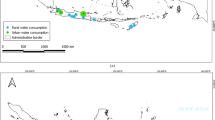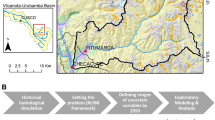Abstract
Drinking water quality is mainly influenced by the variable quality of source water, which is affected by both meteorological and climate factors. Contrary to medium and large municipalities, small systems do not have appropriate equipment to face important variations of raw water quality, and they do not have enough information either on the impact of these alterations. The objective of this study is to develop a decision-making tool to small system operators allowing the determination of risk periods, based on easily accessible measures. The impact of several raw water quality parameters and climate factors on drinking water quality was under study. A stepwise regression analysis was applied to determine the most important factors. Two of them were retained: the level of UV254 of raw water and average maximal air temperature of 15 days before measurement. These factors are representative of raw water quality or meteorological conditions and are easily accessible to systems with restricted financial capacities. A logistic regression analysis contributed to the estimation of the probability to provide drinking water of bad quality (defined by a drinking water quality index). Finally, results of the analysis were synthetized in a visual tool, allowing the identification of risk periods using the known values of UV254 and average maximal air temperature of 15 days. This tool may strongly contribute to the improvement of drinking water management in small systems, as it provides easily accessible information on the risks of deterioration of drinking water quality using two simple parameters.


Similar content being viewed by others
References
Al Khatib I, Daoud F, Rasmawl F, Wa’rra S, Kassabry (2005) Seasonal variation of bacteriological and chemical quality of drinking water: a case study in a Palestinian district. J Chartered Institution Water Environ Manag 19(3):154–158
Amy GL, Chadyk PA, Chowdhurry ZK (1987) Developing models for predicting trihalomethane formation potential and kinetics. J Am Water Works Assoc 1987(79):89–97
Arora H, LeChevallier MW, Dixon KL (1997) DBP occurrence survey. J Am Water Works Assoc 89(6):60–68
Bishara AJ, Hittner JB (2012) Testing the significance of a correlation with nonnormal data: comparison of Pearson, Spearman, transformation, and resampling approaches. Psychol Methods 17(3):399–417
Bonton A, Rouleau A, Bouchard C, Rodriguez MJ (2011) Nitrate transport modeling to evaluate source water protection scenarios for a municipal well in an agricultural area. Agr Syst 104(5):429–439
Boyacioglu H (2007) Development of a water quality index based on a European classification scheme. Water Sa, 33(1)
Canadian Municipal Water Consortium (2014) 2014 Canadian municipal water priorities report
CCME (1999) Canadian water quality guidelines for the protection of aquatic life: Canadian water quality index 1.0 technical report. Winnipeg, Manitoba: Canadian environmental quality guidelines. ISBN 1-896997-34-1
Chen C, Zhang XJ, Zhu LX, Liu J, He WJ, Han HD (2008) Disinfection by-products and their precursors in a water treatment plant in North China: Seasonal changes and fraction analysis. Sci Total Environ 397:140–147
Clark RM, Sivaganesan M (1998) Predicting chlorine residuals and formation of TTHMs in drinking water. J Environ Eng - ASCE 124(12):1203–1210
Conestoga-Rovers, Associates (2010) Study on operation and maintenance of drinking water infrastructure in Newfoundland and Labrador. Ref. no: 055425 (7)
Coulibaly HD, Rodriguez MJ (2003) Spatial and temporal variation of drinking water quality in ten small Quebec utilities. J Environ Eng - ASCE 2:47–61
Crittenden JC, Hand RR, Hand DW, Howe KJ, Tchobanoglous G (2005) Physical aggregate characteristics of water. [book auth.] MWH. Water treatment principles and design. 2e. Hoboken: John Wiley and Sons, Inc., 2005, 2, pp. 44–56
Croué JP (2007) Dissolved organic nitrogen as a precursor of chloroform, SUVA. Environ Sci Technol 41(15):5485–5490
Delpla I, Jung A-V, Baures E, Clement M, Thomas O (2009) Impacts of climate change on surface water quality in relation to drinking water production. Environ Int 35(8):1225–1233
Derksen S, Keselman HJ (1992) Backward, forward and stepwise automated subset selection algorithms: frequency of obtaining authentic and noise variables. Brit J Math Stat Psy 45:265–282
Dojlido J, Raniszewski J, Woyciechowska J (1994) Water quality index applied to rivers in the Vistula river basin in Poland. Environ Monit Assess 33(1):33–42
Environment Canada (2013) National climate data and information archive. [Online] http://climate.weatheroffice.gc.ca. Consulted on 11 July 2014
Ferguson C, Husman AMR, Altavilla N, Deere D, Ashbolt N (2003) Fate and transport of surface water pathogens in watersheds. Critical Rev Environ Sci Tech 33(3):299–36
Fokmare AK, Mussadiq M (2001) Comparative studies of physico-chemical and bacteriological quality of surface and ground water at Akola (Maharashtra). Pollut Res 20(4):651–655
Francisque A, Rodriguez MJ, Miranda-Moreno LF, Sadiq R, Proulx F (2009) Modeling of heterotrophic bacteria counts in a water distribution system. Water Res 43:1075–1087
Giri S, Singh AK (2014) Assessment of surface water quality using heavy metal pollution index in Subarnarekha River, India. Water Qual Expo Health 5(4):173–182
Gouvernement du Québec (2012) Règlement sur la qualité de l’eau potable. Gazette Officielle du Québec, 144e année, n°8
Harvey R, Lye L, Khan A, Paterson R (2011) The influence of air temperature on water temperature and the concentration of dissolved oxygen in Newfoundland Rivers. Canadian Water Resources J 36(2):171–192
Health Canada (2010) Guidelines for Canadian Drinking Water Quality, Ontario, Canada. http://www.hc-sc.gc.ca/ewh-semt/pubs/water-eau/2010-sum_guide-res_recom/index-eng.php. Accessed 7 Feb 2012
Hocking RR (1976) The analysis and selection of variables in linear regression. Biometrics 32:1–49
Hong HC, Huang FQ, Wang FY, Ding LX, Lin HJ, Liang Y (2013) Properties of sediment NOM collected from a drinking water reservoir in South China, and its association with THMs and HAAs formation. J Hydrol 476:274–279
Hosmer DW, Lemeshow S, Sturdivant RX (2013) Applied logistic regression. Hoboken, New Jersey: John Wiley and Sons, Inc., 2013, 5., pp. 153–223
Hrudey SE, Hrudey E (2004) Safe drinking water - lessons from recent outbreaks in affluent nations. London, UK : TJ International (Ltd.), Padstow, Cornwall, UK, ISBN: 1 84339 042 6
Hurley T, Sadiq R, Mazumder A (2012) Adaptation and evaluation of the Canadian council of ministers of the environment water quality index (CCME WQI) for use as an effective tool to characterize drinking source water quality. Water Res 46(11):3544–3552
Hurvich CM, Tsai C-L (1989) Regression and time series model selection in small samples. Biometrika 76(2):297–307
Kallidaikurichi S, Rao B (2010) Index of drinking water adequacy for the Asian economies. Water Policy 12(Suppl 1):135–154
Landwehr JM, Deininger RA, Harkins RD (1974) An objective water quality index. J Water Pollut Con F, pp. 1804–1809
Levallois P, Ayotte P, Louchini R, Desrosiers T, Baribeau H, Phaneuf D, Gingras S, Dumas P, Zee J, Poirier G (2000) Sources of nitrate exposure in residents of rural areas in Quebec, Canada. J Expo Anal Environ Epidemiol 10(2):188–195
MDDEFP (2004) Bilan de la qualité de l’eau potable au Québec 1995–2002. ISBN 2-550-42108-6
MDDELCC (2014) Infoclimat. http://www.mddelcc.gouv.qc.ca/climat/surveillance/produits.htm. Consulted in August 2014
Menard S (1995) Applied logistic regression analysis. Thousand Oaks, CA: Sage, 1995, Sage University Paper series on Quantitative Applications in the Social Sciences, pp. 7–106
Milot J, Rodriguez MJ, Sérodes JB (2000) Modeling the susceptibility of drinking water utilities to form hogh concentrations of trihalomethanes. J Environ Manage 60:155–171
Munna GM, Chowdhury MMI, Ahmed AM, Chowdhury S, Alom MM (2013) A Canadian water quality guideline-water quality index (CCME-WQI) based assessment study of water quality in Surma River. J Civil Eng Construction Technol 4(3):81–89
Ouyang Y, Nkedi-Kizza P, Wu Q, Shinde D, Huang C (2006) Assessment of seasonal variation in surface water quality. Water Res 40:3800–3810
Pastor J, Solin J, Bridgham SD, Updegraff K, Harth C, Weishampel P, Dewey B (2003) Global warming and the export of dissolved organic carbon from boreal Peatlands. Oikos 100(2):380–386
Peng C-YJ, Lee KL, Ingersoll GM (2002) An introduction to logistic regression analysis and reporting. J Educ Res 96(1):3–14
Prati L, Pavanello R, Pesarin F (1971) Assessment of surface water quality by a single index of pollution. Water Res 5(9):741–751
Rathbun RE (1996) Regression equations for disinfection by-products for the Mississippi, Ohio and Missouri rivers. Sci Tot Environ 191:235–244
Rodriguez MJ, Vinette Y, Sérodes J-B, Bouchard C (2003) Trihalomethanes in drinking water of greater Québec region (Canada): occurrence, variations and modelling. Environ Mon Assess 89(1):69–93
Rodriguez MJ, Sérodes J, Levallois P, Proulx F (2007) Chlorinated disinfection by-products in drinking water according to source, treatment, season, and distribution location. J Environ Eng Sci 6:355–365
Rossman L, Clark R, Grayman W (1994) Modeling chlorine residuals in drinking water distribution systems. J Environ Eng 120:803–820
SAS Institute Inc (2013) What’s new in SAS 9.4. SAS Institue Inc, Cary
Scheili A, Rodriguez MJ, Sadiq R (2014) Seasonal and spatial variations of source and drinking water quality in small municipal systems of two Canadian regions. Sci Tot Environ 508:514–524
Sharma R, Agarawal A (2009) Influence of organic fertilizers on total chlorophylle content and yield of wheat (Triticum aestivum). Ecology, Environ Conservation 15(3):539–541
Singer PC, Reckhow DA (1999) Chemical oxidation. Letterman R.D. technical editor. Water quality and treatment. 5th.McGraw-Hill : J Am Water Works Assoc, 1999
SPSS Inc. Released (2004) SPSS for windows, version 13.0. SPSS Inc, Chicago
Stuart ME, Gooddy DC, Hughes AG, Jackson CR (2006) A field and modeling study to determine pesticide occurrence in a public water supply in northern England, UK. Groundwater Monit R 26(4):128–136
Tabinda AB, Ayub M (2010) Effect of higher phosphate fertilization rate on pond phosphate concentrations, chlorophylle a, and fish growth in carp polyculture. Aquacult Int 18(3):285–301
USEPA (2011) National characteristics of drinking water systems serving 10,000 or fewer people. Office of Water (4606M), EPA 816-R-10-022, July 2011
USEPA (2012) 2012 Edition of the Drinking Water Standards and Health Advisories Tables (Office of Water, U.S. Environmental Protection Agency, Washington, D.C., EPA 822-S-12-001). Available online at http://water.epa.gov/action/advisories/drinking/upload/dwstandards2012.pdf
Weishaar JL, Aiken GR, Bergamaschi BA, Fram MS, Fujii R, Mopper K (2003) Evaluation of specific ultraviolet absorbanceas an indicator of the chemocal composition and reactivity of dissolved organic carbon. Environ Sci Tech 37:4702–4708
Wrobel LC, Brebbia CA (1991) Computational modelling of free and moving boundary problems: fluid flow (Vol. 1). Walter de Gruyter
Zalidis G, Stamatiadis S, Takavakoglu V, Eskridge K, Misopolinos N (2002) Impacts of agricultural practices on soil and water quality in the Mediterranean region and proposed assessment methodology. Agr Ecosyst Environ 88(2):137–146
Zidane F, Cheggari K, Blais JF, Drogui P, Bensaid J, Ahmed SI (2010) Contribution à l’étude de l’effet de la coagulation avant chloration sur la formation des trihalométhanes (THM) et composés organohalogénés (COX) dans les eaux alimentant la ville de Casablanca au Maroc. Revue Canadienne de Génie Civile 37:1149–1156
Zou R, Riverson J, Liu Y, Murphy R, Sim Y (2015) Enhanced nonlinearity interval mapping scheme for high‐performance simulation‐optimization of watershed‐scale BMP placement. Water Resour Res 51(3):1831–1845
Acknowledgments
The authors thank the Department of Environment and Conservation of Newfoundland and Labrador and the Ministère du Développement durable, de l’Environnement et de la Lutte contre les changements climatiques of Quebec for their support in logistics. They also thank the operators and managers of the 25 small systems under study for their valuable contribution. The authors also thank Sabrina Simard, Catherine Mercier-Shanks, Michel Bisping, and all their assistants for their help at the laboratory and in the field, as well as Christelle Legay and Stéphanie Guilherme for their field help and Hélène Crépeau for her statistical assistance. Financial support for this project was received from the Natural Sciences and Engineering Research Council of Canada (NSERC) through RES’EAU research network.
Author information
Authors and Affiliations
Corresponding author
Rights and permissions
About this article
Cite this article
Scheili, A., Delpla, I., Sadiq, R. et al. Impact of Raw Water Quality and Climate Factors on the Variability of Drinking Water Quality in Small Systems. Water Resour Manage 30, 2703–2718 (2016). https://doi.org/10.1007/s11269-016-1312-z
Received:
Accepted:
Published:
Issue Date:
DOI: https://doi.org/10.1007/s11269-016-1312-z




